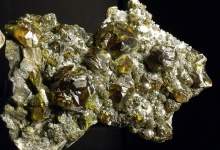

2014 was a notoriously bad year for most mineral commodities. As oil prices dropped, and global currencies oscillated in response, we have seen well-documented price declines in copper, gold and iron ore.

Discover B2B Marketing That Performs
Combine business intelligence and editorial excellence to reach engaged professionals across 36 leading media platforms.
With copper plummeting 23% over the period, and iron ore 47%, there seems to be no clear reversal of fortunes on the horizon. The Bloomberg Commodity Index of 22 raw materials, which fell 17% last year, has already dipped a further 2.4%. Meanwhile, the US bank Goldman Sachs has slashed its three-year forecasts for these commodities by 10-20%.
That said, against a backdrop of oversupply and under-demand, certain outliers have given investors a glimmer of hope. Chief among these is zinc. In mid-2014, a Forbes headline posed the question, "Could zinc be the next base metals star?", with a later piece proclaiming: "Zinc springs back to life".
Over the summer, the metal surged by 5% in a single two-week period.
"2014 was a good year for zinc prices," says Clifford Smee, lead analyst for mining at Timetric Australia. "LME Zinc prices averaged $2,164 which was 13% higher than 2013. In comparison to all other major mined commodities zinc way outperformed, except for nickel which also had a 13% increase in prices. Most other commodities saw lower prices in 2014."

US Tariffs are shifting - will you react or anticipate?
Don’t let policy changes catch you off guard. Stay proactive with real-time data and expert analysis.
By GlobalDataChina drives demand
As a galvanising metal, zinc is used to prevent steel, aluminium and iron from rusting. Because it is more reactive than the metals it coats, it will attract oxidisation and form a layer of oxide and carbonate, protecting those metals from corrosion. It is therefore used widely in construction industries, which rely heavily on stainless steel.
Mining-technology.com profiles the ten biggest zinc producing countries based on latest production and reserve data..
In 2014, the metal faced an estimated production deficit of 403,000 tons (six times higher than the year before) driven predominantly by activity in China. As a rapacious zinc consumer, China is responsible for nearly half of global demand, compared with 17% for Western Europe and just 7% for North America.
Following a recent upsurge in infrastructure projects, Chinese demand for zinc has soared, with applications spread across everything from cars to railway lines to power pylons. Even as economic growth slows, this reliance is expected to continue well into 2015.
Overstretched supply
At the same time, global supply is falling significantly. MMG Century’s Century mine in Australia, one of the world’s biggest sources of zinc, is due to close next year, with output expected to decline by up to 31% as it moves into its final months of production. Once this reserve runs dry, it will diminish the world’s zinc supply by around 5%.
Meanwhile, Glencore’s Brunswick and Perseverance mines in Canada already shut up shop in 2013, and several further mines elsewhere in the world are nearing the point of depletion. Users will be forced to draw upon existing stockpiles of metal.
"A mined zinc deficit of over 200kt could be produced in 2014 due to a number of large mines being exhausted," says Smee. "This deficit is supply induced rather than robust demand."
The outlook
This unique combination of factors – propitious for investors, less so for consumers – means prices are likely to rise both this year and next. Patricia Mohr of the Bank of Nova Scotia told The Global Mail that she expected the average to climb from $0.98 per pound in 2014 to $1.10 per pound this year, and as much as $1.60 in 2016.
"Prices will probably rise due mine closures, and coming mined zinc deficit," agrees Smee. "On a fundamental basis (supply and demand) prices could rise by 5-6%. However prices in base metals, at least in the short term, are driven by trader sentiment, hence the 2015 price rise could be greater."
Present trends, it seems, are set to continue, at least in the short to medium term. While there are new mining developments on the horizon – not least MMG’s Dugald River project in Queensland – these have been slow to progress and we can expect to see further supply shortfalls for the time being. In fact, the gap between supply and demand may not be bridged until 2018, as old mines run dry and new mines put the brakes on production.
"Zinc is one of the few commodities with good supply and demand fundamentals," says Smee. "Many other commodities, such as iron ore and coal, face significant surplus global supply. In contrast the zinc market faces this supply deficit. It will likely be some time before the global industry overcomes this deficit, due to the large operations that have exhausted their reserves and few large scale operations in the pipeline."


.gif)



